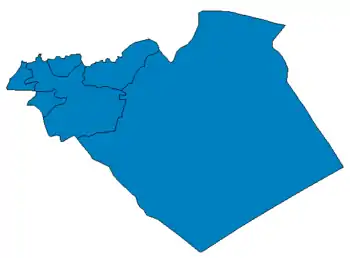Rablah
ربلة | |
|---|---|
Village | |
 Rablah Location in Syria | |
| Coordinates: 34°27′7″N 36°33′24″E / 34.45194°N 36.55667°E | |
| Country | |
| Governorate | Homs |
| District | Al-Qusayr |
| Subdistrict | Al-Qusayr |
| Population (2004) | |
| • Total | 5,328 |
| Time zone | UTC+3 (EET) |
| • Summer (DST) | UTC+2 (EEST) |
Rablah (Arabic: ربلة; also spelled Rableh, Ribla or Ribleh) is a town in central Syria, administratively part of the Homs Governorate, located southwest of Homs. Just east of the border with Lebanon, nearby localities include al-Nizariyah to the southwest, Zita al-Gharbiyah to the northwest, al-Qusayr to the north, Zira'ah to the northeast and Hisyah to the east. According to the Central Bureau of Statistics (CBS), Rableh had a population of 5,328 in the 2004 census.[1] Its inhabitants are predominantly Greek Catholics.[2][3][4]
History
It is considered to be the site of the ancient town of Riblah (Numbers 34:11 ), whose tell is covered by a cemetery not far from the modern town.[5][6] In Roman times, the town also bore the name Daphne.[7]
References
- ↑ General Census of Population and Housing 2004. Syria Central Bureau of Statistics (CBS). Homs Governorate. (in Arabic)
- ↑ Smith, 1841, p. 176.
- ↑ Choufi, Firas. On the Frontline of the Battle for Syria’s Lebanese Villages. 2013-03-02.
- ↑ "Updated List of Churches and Monasteries and Shrines Damaged in the Syrian Crisis (22 Dec 2013)". Byzantine Catholic Church in America. Retrieved 2016-05-26.
- ↑ Avraham Negev and Shimon Gibson (2001). Riblah. New York and London: Continuum. p. 435. ISBN 0-8264-1316-1.
{{cite book}}:|work=ignored (help) - ↑ Ferrell Jenkins (2 March 2009). "Riblah in the land of Hamath". Ferrell's Travel Blog. Retrieved 2015-09-23.
- ↑ Saadia Gaon (1984). Yosef Qafih (ed.). Rabbi Saadia Gaon's Commentaries on the Pentateuch (in Hebrew) (4 ed.). Jerusalem: Mossad Harav Kook. p. 164 (note 6). OCLC 232667032., citing Targum Jonathan and Bar Droma, Chaim (1958). Wezeh gevul haares: the true boundaries of the Holy Land according to the sources (in Hebrew). Jerusalem: Hotsaʼat sefarim Beʼer le-ḥeḳer ha-Miḳra ṿeha-arets. p. 273. OCLC 654298149.
Bibliography
- Smith, Eli; Robinson, Edward (1841). Biblical Researches in Palestine, Mount Sinai and Arabia Petraea: A Journal of Travels in the Year 1838. Vol. 3. Crocker and Brewster.
This article is issued from Wikipedia. The text is licensed under Creative Commons - Attribution - Sharealike. Additional terms may apply for the media files.

